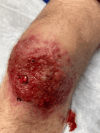A Case Report of Human Cutaneous Neosartorya hiratsukae Infection
- PMID: 39385890
- PMCID: PMC11463825
- DOI: 10.7759/cureus.69012
A Case Report of Human Cutaneous Neosartorya hiratsukae Infection
Abstract
We present a case of a human cutaneous infection caused by Neosartorya hiratsukae in a 19-year-old male on adalimumab. While on a trip to Israel, the patient sustained a left knee abrasion after a fall while hiking, and subsequently went swimming in the Red Sea. The patient gradually developed a large, non-healing, erythematous, ulcerated plaque on the left knee. Initial biopsy and tissue cultures were negative for infection, but due to a high suspicion for infection, further diagnostic testing was conducted. Broad range polymerase chain reaction and next-generation sequencing was performed, and 28S rDNA sequencing was positive for Neosartorya hiratsukae, a rare infectious agent in humans. This case highlights the importance of considering uncommon sources, such as fungal etiologies, in the differential diagnosis of non-resolving lesions, particularly in immunosuppressed patients. Furthermore, this case emphasizes the significance of advanced molecular techniques in identifying uncommon pathogens.
Keywords: aspergillus; fungal infection; israel; neosartorya hiratsukae; next generation sequencing (ngs); voriconazole.
Copyright © 2024, Patel et al.
Conflict of interest statement
Human subjects: Consent was obtained or waived by all participants in this study. Conflicts of interest: In compliance with the ICMJE uniform disclosure form, all authors declare the following: Payment/services info: All authors have declared that no financial support was received from any organization for the submitted work. Financial relationships: All authors have declared that they have no financial relationships at present or within the previous three years with any organizations that might have an interest in the submitted work. Other relationships: All authors have declared that there are no other relationships or activities that could appear to have influenced the submitted work.
Figures


Similar articles
-
Allergic fungal rhinosinusitis caused by Neosartorya hiratsukae from India.Med Mycol. 2009 May;47(3):317-20. doi: 10.1080/13693780802562977. Epub 2008 Feb 2. Med Mycol. 2009. PMID: 19212892
-
First case of fungal peritonitis caused by Neosartorya hiratsukae in China.Med Mycol Case Rep. 2024 Oct 18;46:100676. doi: 10.1016/j.mmcr.2024.100676. eCollection 2024 Dec. Med Mycol Case Rep. 2024. PMID: 39502836 Free PMC article.
-
Neosartorya hiratsukae peritonitis through continuous ambulatory peritoneal dialysis.J Med Microbiol. 2010 Jul;59(Pt 7):862-865. doi: 10.1099/jmm.0.019133-0. Epub 2010 Apr 15. J Med Microbiol. 2010. PMID: 20395379
-
Aspergillus fumigatus-Related Species in Clinical Practice.Front Microbiol. 2016 May 17;7:683. doi: 10.3389/fmicb.2016.00683. eCollection 2016. Front Microbiol. 2016. PMID: 27242710 Free PMC article. Review.
-
Intraarticular Inflammatory Myofibroblastic Tumor of the Left Knee With ALK-CARS Fusion Detected With Archer Fusionplex Sarcoma NGS Panel: Case Report and Literature Review.Int J Surg Pathol. 2021 Apr;29(2):216-222. doi: 10.1177/1066896920937770. Epub 2020 Jul 7. Int J Surg Pathol. 2021. PMID: 32631118 Review.
References
-
- Neosartorya hiratsukae peritonitis through continuous ambulatory peritoneal dialysis. Koutroutsos K, Arabatzis M, Bougatsos G, Xanthaki A, Toutouza M, Velegraki A. J Med Microbiol. 2010;59:862–865. - PubMed
-
- Allergic fungal rhinosinusitis caused by Neosartorya hiratsukae from India. Shivaprakash MR, Jain N, Gupta S, Baghela A, Gupta A, Chakrabarti A. Med Mycol. 2009;47:317–320. - PubMed
-
- Fungal peritonitis in patients on peritoneal dialysis: twenty five years of experience in a teaching hospital in Argentina. Predari SC, de Paulis AN, Verón D, Zucchini A, Santoianni JE. https://www.redalyc.org/pdf/2130/213016793005.pdf. Rev Argent Microbiol. 2007;39:213–217. - PubMed
Publication types
LinkOut - more resources
Full Text Sources
